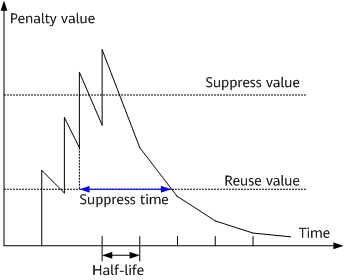Route Dampening
Route instability is reflected by route flapping. When a route flaps, it repeatedly disappears from the routing table and then reappears.
If route flapping occurs, the router sends an Update packet to its peers. After the peers receive the Update packet, they recalculate routes and update their routing tables. Frequent route flapping consumes lots of bandwidth and CPU resources and can even affect network operations.
Route dampening can address this problem. In most cases, BGP is deployed on complex networks where routes change frequently. To reduce the impact of frequent route flapping, BGP adopts route dampening to suppress unstable routes.
BGP dampening measures route stability using a penalty value. The greater the penalty value, the less stable a route. Each time route flapping occurs (a device receives a Withdraw or an Update packet), BGP adds a penalty value to the route carried in the packet. If a route changes from active to inactive, the penalty value increases by 1000. If a route is updated when it is active, the penalty value increases by 500. When the penalty value of a route exceeds the Suppress value, the route is suppressed. As a result, BGP does not add the route to the routing table or advertise any Update message to BGP peers.
The penalty value of a suppressed route reduces by half after a half-life period. When the penalty value decreases to the Reuse value, the route becomes reusable, and BGP adds the route to the IP routing table and advertises an Update packet carrying the route to BGP peers. The penalty value, suppression threshold, and half-life are configurable. Figure 1 shows the process of BGP route dampening.
